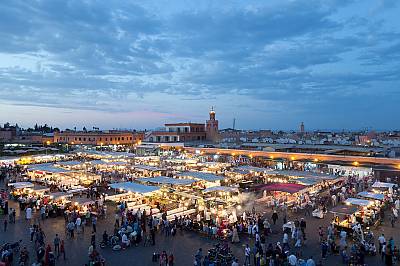- Morocco


The Cultural Space of Jemaa el-Fna in Morocco

© “Djemaa el Fna” by Weekender73 is licensed under CC BY-SA 3.0
1. ICH domains
Oral traditions and expressions, performing arts, social practices, festive events, traditional craftsmanship
2. Short description
Jemaa el-Fna Square is one of the main cultural spaces in Marrakesh and has served as the city’s unique historical and central meeting-place since its foundation in the eleventh century. The square, which is surrounded by restaurants, stands and public buildings, provides a space for everyday commercial activities and various forms of entertainment and is an important spatial and cultural core of Morrocco’s urban environment.
The cultural manifestations which take place in the square are many and varied, and consist primarily in a vast range of shows and performances. These include storytelling, acrobatics, musical recitals, comic acts and stunts, dancing, animal shows among others. Other activities take the form of fortune-telling, astrology, numerology, one-hole miniature golf, and preaching. The space also serves as a site for public festivities and rituals that possess a powerful symbolic significance to the community, which during official festivities, can attract thousands. As such, it is the basis of a rich urban culture comprising several outstanding forms of linguistic, musical, religious and artistic expression. The square lies at the heart of the identity of the mix of peoples involved, and functions as a major locus of intercultural exchange. The square has given Marrakech the reputation of a city unifying various cultural contributions.
The actors who perform their activities on the square are aware of the importance of their knowledge and expertise and are continually working to ensure the continuity of their activities. Associations defend their interests and provide them with a voice vis-à-vis the authorities and other stakeholders involved in the management of the square.
Jemaa el-Fna Square has enjoyed protection as part of Morocco’s artistic heritage since 1922. It was inscribed in 2008 on UNESCO’s Representative List of the Intangible Cultural Heritage of Humanity (https://ich.unesco.org/en/RL/cultural-space-of-jemaa-el-fna-square-00014).
Further information:
For additional write-ups and photos depicting Jemma el-Fna at night, see:
http://www.bbc.com/travel/story/20111213-a-day-in-the-life-of-marrakesh
https://www.alhalqa-virtual.com/index.php/en/
3. Link with sustainable development
While Jemaa el-Fna provides a sharing space (e.g. fun, joy, knowledge), it also provides income and employment opportunities. In addition to being a location for performing artists, narrators and other creators, the square is an important place for mercantile activities, offering an array of products and gastronomic treasures of Marrakech, another aspect of the intangible cultural heritage of the city. More broadly, Jemaa el-Fna echoes the commitment of SDG 8 to promote inclusive and sustainable economic growth, employment and decent work for all. The cultural exchange and heritage of Jemaa el-Fna creates an inclusive space in the city and contributes to SDG 11 in fostering sustainable cities and communities.
4. Questions for reflection
Traditional methods of transmission, previously based on learning through observation, are today threatened, particularly with regard to specific performances. The public grants but a brief moment to storytellers, before passing on to other presentations. Although the influx of tourists is fast expanding, the number of storytellers is decreasing, and the number of other practitioners (e.g. tattoo artists) is increasing. The threat to traditional transmission mechanisms, the “folklorisation” of the square, the negative effects of tourism, the expansion of increased commercial activities and changes in attitudes among youth, challenge the sustainability of the practices that are the very essence of Jemaa el-Fna.
In part a response to such change, a spatial distribution was introduced to ensure that practitioners work in conditions that are favourable to their businesses, including a limiting of spaces reserved for commercial and restaurant use, which ran the risk of expanding at the expense of the performances constituting the cultural and heritage aspects of the square.
What can entice storytellers to come back to the square? What possible safeguarding measures could be put in place to entice young people to the art of storytelling?
What other safeguarding measures could be taken to strike a balance between the demand for tourism and the creation of jobs and the desire not to ‘decontextualize’ an element?
For further details on safeguarding measures, see the periodic report submitted by Morocco to UNESCO:
https://ich.unesco.org/en/state/morocco-MA?info=periodic-reporting#pr-2013-2013